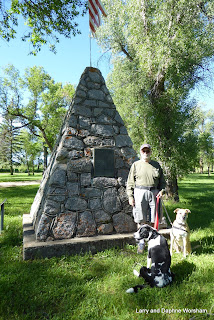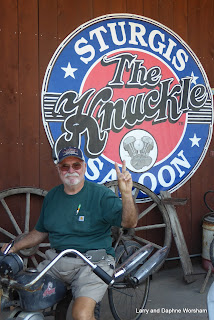June 6, Tuesday
 |
| Roubaix Lake |
We'll be staying at a Forest Service campground,
Roubaix Lake (Row-bay) for the next few days.
We just missed the weekend crowd and practically have the place to ourselves. There's fishing here, and beautiful scenery. . . and weather. Sun, puffy clouds, rain and hail, pretty much in that order. They need the rain here though, so no one's complaining.
Our first stop is Deadwood. Though the name of the town conjures up images of gunfights and the like, it was actually named for a bunch of dead trees in the gulch near the settlement. The reputation as a gunslingers hangout was earned though. It seems every notorious bad guy (and a few women) hung their hat here for at least one night.
Butch Cassidy and Sundance, for example. They robbed a bank in nearby Belle Fourche (Bell-foosh), which didn't have a jail, so the authorities brought them to Deadwood to be held until they could move them to the proper authorities. They escaped during the night, and weren't heard of here again.
Gunslingers looking for a job in law enforcement were drawn to communities like this and Wild Bill Hickok was no exception.
Quick, and accurate, on the draw, he had been fired by his previous employers for (accidentally) shooting and killing his deputy. He showed up here looking for a job and ended up primarily playing cards - something he was pretty good at. Unfortunately he hadn't been here long when he decided to join a game at a table with only one chair available, and it faced away from the door. That was his undoing, and he was shot in the back of the head. Another legend made. He's been immortalized here, with statues, hotels, sandwiches and who knows what else carrying his name.
 |
| Site of Wild Bill's murder |
Deadwood was born when Custer and his men discovered gold in the surrounding hills. The population swelled to over 5,000, then the mines petered out and people began to drift away. Deadwood's population currently is about 12,700 .
Funds have been raised in a variety of ways and the town has done a great job of restoration on the original buildings. New structures mostly blend in pretty well, but, the town at this point is largely casinos, hotels, B & Bs with a few museums and a bit of theater thrown in for flavor. The historic downtown area is pretty tight as far as traffic goes, and it's not very relaxing to try to navigate strange streets and take in the sites too, so we opted for a one hour tour ($10/head). 'Worth the money - good stories about some of the historic figures, brief tour of the cemetery, and plenty of chances to take photos. You can always go back to an area for more in depth touring if you are so inclined.

In the cemetery our attention was directed to the burial places of Wild Bill Hickock and Clamity Jane, but the tour guide didn't mention another one that caught my eye nearby. . . James Leighton Gilmore - the first legal execution in the state. He was born in Steubenville, OK, moved west to find his fortune, and the rest of his story is
here.
On the way home we took a quick, fly-by tour of the closest town, Lead ( as in, lead, don't follow).
The town was named for the veins (leads) of gold that miners were working in the surrounding hills. Once the second largest town in the state with a population of over 8,000, the town now has a population of a little over 3,000. It's much calmer and less touristy than Deadwood, but still rich in history.
June 7, Wednesday
Sturgis was the next stop on our list.
Motorcycles motorcycles motorcycles. . . . that's the theme, of everything!
Bars, babes and bikes. There's a real town hidden somewhere underneath all the promotional stuff, but summer is the time for this town to make it's income on the tourists, and they are all here because of the reputation, so they have to live up to it. There are some fun themes, and no end of T-shirt shops, the streets are wide, so with the current, not too busy, time of year navigation wasn't a problem. We did a bit of shopping then headed for Fabric Junction so I could shop for a current project. I picked up some yardage for the project, a fabric license plate, and some souvenir fabric.
A little research indicated a nearby museum at historic
Fort Mead. We thought it sounded interesting so we popped into a local sandwich shop and picked up a quick lunch. I'd read that there were picnic facilities at Fort Mead, so we headed for the fort, sandwiches in hand.
Other than the stiff breeze that kept blowing our chips off the table it was a perfect plan. We ate lunch, wandered around the beautiful grounds to give the dogs a bit of a break, and then worked our way toward the museum. A very friendly and helpful docent greeted us, showed us a brief film depicting the fort's history, and then we spent quite a little time wandering the labyrinth of rooms with displays.
A few highlights of what we learned:
The 7th Cavalry, re-formed after the disastrous Battle of the Little Big Horn in 1876, constituted the first permanent garrison of the post. Its commander, Colonel Samuel D Sturgis, was on of the founders of the nearby town that bears his name.
It was at Fort Meade that the Cavalry horse named Comanche, the only living thing found on the Little Big Horn Battlefield, was officially retired with military honors.
Comanche lived a long life at the fort, leading parades - with no rider - and serving other ceremonial functions until he passed away. It was here, too, that the Star Spangled Banner first became the official music for the military retreat ceremony, long before in became the National Anthem. A display in the fort museum gives the fort commander's wife credit for urging the adoption of the song as the national anthem.
When we left camp in the morning it was beautiful and sunny, by the time we were eating lunch in Sturgis the sky was darkening, and by the time we got back to camp it was clear we'd just missed a thunderstorm.
It turns out that this is the rainy season in this part of the world. We totally missed this particular storm just by being a few miles away.

It was thundering when we pulled into camp, so the dogs decided they'd rather hop into the trailer than sit outside.
Roubaix Lake campsites are $24 per night, though they do accept the federal passes for discount, and there's also a $2 pet fee per pet, per night.
Deadwood and Sturgis album

















































